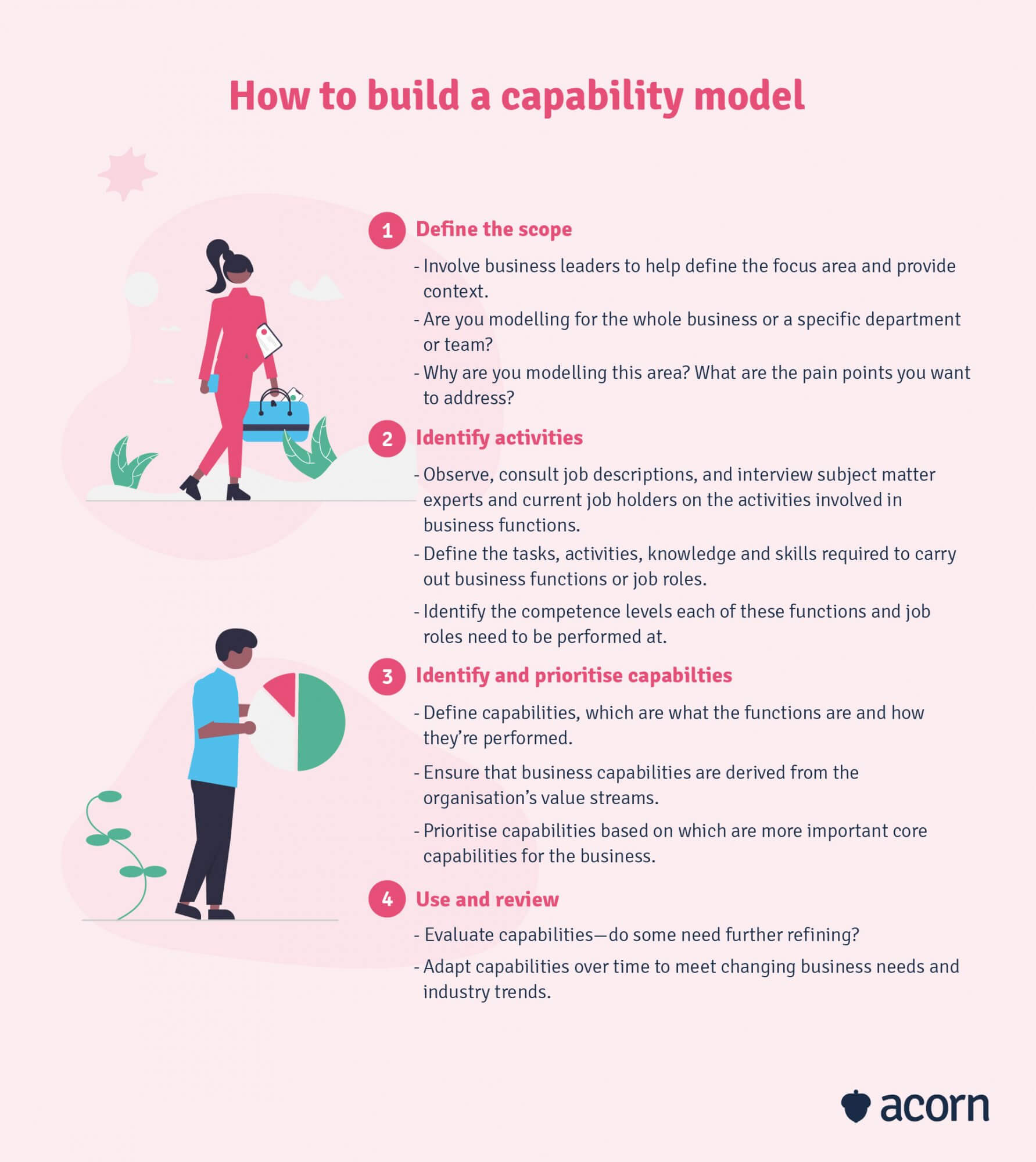What is Capability Modeling and Why is it Important?
Reading Time:

Lead the pack with the latest in strategic L&D every month— straight to your inbox.
SubscribeBusinesses are driven by their capabilities, so it goes without saying that you need to understand the skills, knowledge and behaviors necessary for yours to function.
By organizing and prioritizing capabilities, you can cut through the technical jargon related to specific job roles and business functions. That reveals the specific criteria needed to push performance closer to its desired target state. How to do that? With a capability model.
Capability modeling can be as focused as one job role or as broad as an entire organization. That’s because business capabilities provide a universal language; they can show employees the responsibilities of their roles and how their work impacts the company, or they can visualize the structure of an entire organization.
In this article, we’ll dive into the importance of capability models and how they can be created to forge the best business drivers for organizational success.
What is modeling?
In simple terms, modeling is about displaying or providing visibility. In business, modeling is a visual representation of data for internal and external business stakeholders, so they can better understand the organization, its current capabilities, and its future plans and strategy.
What is capability modeling?
With that in mind, capability modeling—or capability mapping—is a visual representation of the functions, outcomes, expertise, knowledge, behaviors, and activities required for an organization and its employees to carry out core business operations.
What does a capability model do?
If a capability framework is how work gets done, capability modeling is about defining what work needs to get done. It’s all about ensuring a company has the right people in the right jobs.
Side note: you may hear talk of business capability maps or business capability models. The business capability map is similar in function to the standard capability model, but it focuses specifically on business capabilities (i.e., the most strategic “what” of how businesses function). Business capability modeling seeks to support the organization’s most strategic priorities, so may not apply to all use cases.
More broadly, capability modeling provides a definitive guide to the capabilities needed in individual teams, business units, and the organization as a whole, which the organization can then use to build a business roadmap. In short: a model is essentially the map key for the roadmap.
That makes it easier for your organization to do things like:
- Define clear job descriptions with specific capability requirements
- Ensure employees have the capabilities needed for their role now and into the future
- Develop L&D initiatives to build capabilities for future business needs
- Measure and define competency for targeted performance management plans.
The one thing to note about modeling business capabilities is that it can be a rather static activity. That is, you won’t continually do it over and over again, though you may revisit it here and there. A static business artifact has greater potential to go unused (compared to a living document that needs eyes on it), so you need a way to make your model constantly usable.
The trick is in your tech. Most solutions lean towards skills, which are only part of the capability picture. Ergo, you need to look for tech geared towards building capability. We created the first performance learning management system (PLMS) to do more than just find and model capabilities; the PLMS helps map them to job roles (hello, clearer job descriptions), learning content (for more targeted and dynamic L&D), and even helps you define as many competency levels as you like (making it easier to talk about performance).
How to build a capability model
Building a capability model isn’t as easy as saying, “We need this, that, and the other to achieve our business strategy.” As with all things worth doing, it is a little more involved.
That said, there are just four core steps to building a capability model.
- Define the scope of the capability model
- Identify job tasks
- Define and prioritize capabilities
- Implement and review.
Step 1: Define the scope
Scope refers to the focus area—a specific role, team, department, or business function you want to improve or evolve. Start by asking yourself why this is a priority and what pain points need to be streamlined for the business to run more efficiently.
Understanding the breadth required will determine how much detail to include in your model. If you’re creating a whole-of-business capability model, that means you’ll look at greater strategic capability sets. Scope also tells you who to bring into the project. For example, the business-level scope means you’d be inviting business architects and business leaders to the table, given business capabilities are entrenched in your company’s value chain.
Step 2: Identify activities
The next step is to ask what tasks, activities, knowledge, skills, and expertise are needed for the chosen job or function. Importantly, which of these are needed to do the job or function to the standard (i.e., competency) it needs to be performed? That’s to say there may be capability gaps between how your workforce performs now and how the same workforce needs to perform in the future.
Best approach here is to use a combination of:
- Observation of daily operations to see firsthand how tasks are executed
- Interviews with both subject matter experts (SMEs) and current job holders to gather insights about the necessary skills and expertise
- Reviews of existing job descriptions and process documentation.
The goal here is to get a holistic view of the real-world, on-the-ground requirements for a role or function. It also helps differentiate between core activities (those that prop up business architecture or drive strategy) and supporting activities (less strategic in nature, but still part of everyday business).
Step 3: Identify and prioritize capabilities
When you know the key tasks and activities, you can start to define and organize capabilities. Capabilities are how you perform skills, tasks, and activities effectively. Look at them as the building blocks of your organization. Bit by bit, they all pull together on strategy.
Typically, capabilities can be grouped into categories like behavioral (e.g., interpersonal skills), operational (e.g., innovation), and dynamic (e.g., learning and adaptability). You can also group capabilities into sets, i.e., functions, cohorts, or departments like Finance or HR. Check out our free Capability Library (with over 1600 capabilities, ready to download!) to see just how many different ways you can categorize capabilities.
When you’ve grouped capabilities, you need to prioritize them. Not all hold the same weight; remember what we said about supporting activities? You need to assess each capability (not just the set) to understand its importance to and impact on strategic priorities.
Consider:
- Business criticality. Is this capability essential for the success of the job or business function?
- Frequency and complexity. How often is this capability used, and how complex is it? Note: both of these factors impact the availability of a given capability at any point in time.
- Capability gaps. Are there current gaps in these capabilities that need urgent attention?
When you know the highest priority capabilities, you can arrange them into a hierarchical structure that shows their relationships and dependencies. While each capability should be unique, they should complement one another. Think about the HR capabilities of talent management and leadership development: unique objectives but complementary agendas.
A hierarchy also makes the capability model easy for users to understand at a glance. (We did say it was a visual representation, didn’t we?)
Step 4: Implement and review
Once you implement your capability model, it’s time to regularly evaluate and review it. The key word there is regularly; not only does this flag areas that need adjustment (say, when job roles are removed or added), but it also makes the model a living document (as previously mentioned). Even if you get your model to be a perfect snapshot of now, evolving business needs and industry changes mean updates will be necessary.
In saying that, capabilities themselves don’t necessarily change (particularly business capabilities), but they can adapt, emerge, or from time to time, become obsolete based on business needs. To ensure your model is always aligned with strategic goals:
- Gather feedback from key users like HR, team leaders, and employees to understand any practical issues with the model
- Review business needs to understand future goals and the capability gaps currently in the way
- Evaluate any outcomes linked to the use of the model, e.g., operational efficiency, training ROI, retention, and engagement.
Regularly reviewing and updating a capability model enables you to remain agile. It also ensures you’re truly linking business capabilities to the processes that need that extra strategic juice, like performance management.
Looking for a step-by-step on building a capability model? Save this checklist:

What are the risks of not modeling capability?
Capabilities are like bricks. They aren’t particularly useful in an unorganized pile. But when shaped into a house, they become a structure that can now be used.
When you don’t organize them, you have no effective way to:
- Understand their purpose in business processes or strategy
- See the relationships between capabilities within job roles, teams, and departments
- Uncover redundancies in roles or activities
- Utilize capabilities to their full potential.
That may mean you end up with employees who are unsure of their responsibilities because of unclear job requirements. Job descriptions may even differ between teams without a universal language to model them (see what we did there?). Biased or inconsistent job descriptions could lead to poor hiring decisions, which in turn can mean decreased morale and increased turnover down the line. (Important given 94% of employees say they would stay at an organization longer if their employer invested in their learning and development.)
Lacking capability modeling means your business likely has nothing to benchmark their performance against. Let’s say you do have a model of existing capabilities, but you’ve not touched it in a couple of years. That can mean finance and HR executives are working with poor data when making strategic decisions, which in turn can affect the validity of any future planning initiatives. Oh, and those issues will have festered in the workforce, given there’s been nothing to link capabilities to their work. Nothing says, “We don’t value your contributions” like “Your work has had no measurable impact on this company up until now”.
The only way to close those capability gaps is with performance management and L&D, but without capability modeling, you’ll have no idea of the highest priority capabilities to focus on. That means your organization won’t understand what is needed to transform the organization, meaning you’ll be left behind in the market.
Key takeaways
If you don’t model capabilities, you don’t know the gaps to be filled or who in your organization does what.
A capability model provides you with the structure to achieve business objectives. Remember that while you want to make it a living document, it’s not meant to answer the question of how work gets done. A capability model shows stakeholders how capabilities support the organizational structure, from a single job role all the way up to the entire business architecture.
Capability models can be created in four simple steps.
- Defining the scope of the problem to focus on
- Identifying activities required for the job role or function
- Identifying and prioritizing capabilities in terms of what is most important to your area of focus
- Regularly reviewing the model to keep up with industry changes.